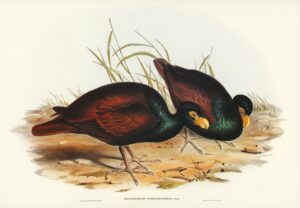For years, a mystery has surrounded wild boars in southeastern Germany. They are radioactive. That alone is not actually that unusual for the area. Many animals had high levels of radioactivity after the 1986 Chernobyl disaster. What is odd is that they are not getting less radioactive. In all other animals, the radioactive cesium levels have decreased, but in the wild boars, it still persists.
Scientists now think they know why the pigs are still radioactive, and Chernobyl is not the sole cause. The new research suggests that nuclear weapons testing in the 1960s was a significant contributor.
The Cold War nuclear tests still affect the soil in the area. Fallout has sunk deep into the soil, contaminating the truffles that the wild boars like to eat. The Chernobyl disaster added even more cesium to the soil. As cesium settles into the soil so slowly (approximately one millimeter per year), it is only now affecting the truffles. This means the radioactive levels could actually increase in the near future.

Figure showing the concentrations of cesium isotopes. The light yellow and blue are the contribution percentages of weapons-135Cs and Chernobyl-137Cs, respectively. Figure: Stager F et al., 2023
Radiation from testing will persist forever
The study also predicts that the problem will not abate any time soon. Cesium-135, the version that is associated with nuclear weapons testing, has a half-life of 2.3 million years. This makes it essentially immortal. Meanwhile, cesium-137, the version used in nuclear reactors such as Chernobyl, has a half-life of just 30 years.
Researchers tested meat from 48 boars across 11 districts in the region. Almost 90% of the samples had a dangerous amount of radioactivity. And between 10% and 68% of the contamination in the individual meat samples bore the isotopic fingerprint of the cesium used in the weapons testing.
“My mind was blown when I realized how relevant this source of radioactive contamination in general still is,” Georg Steinhauser, co-author of the new study, told The Washington Post.

Photo: Shutterstock
Unsafe to eat
The dangerous amount of cesium makes the pigs unsafe to eat. Hunting restrictions are in place so that people don’t accidentally shoot and eat them. But as a result, the wild boar populations in the area are soaring.
The results also highlight the danger of atmospheric nuclear testing. The Cold War tests happened 60 years ago, so many people think that the after-effects are long gone. This proves that this is not the case. Many of these boars would be radioactive even if the Chernobyl explosion had never happened.
It is also impossible to tell which specific tests actually caused the contamination, as the isotopes have spread through the air across the western hemisphere.
“This study illustrates that strategic decisions to conduct atmospheric nuclear tests 60−80 years ago still impact remote natural environments, wildlife, and a human food source today,” the authors concluded.






